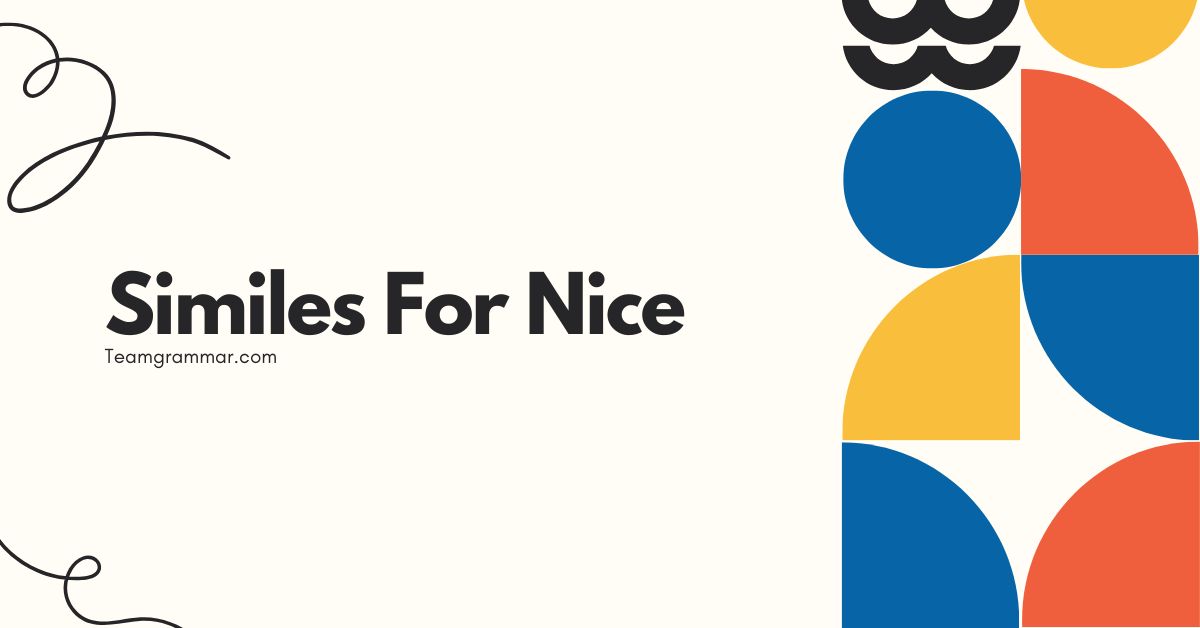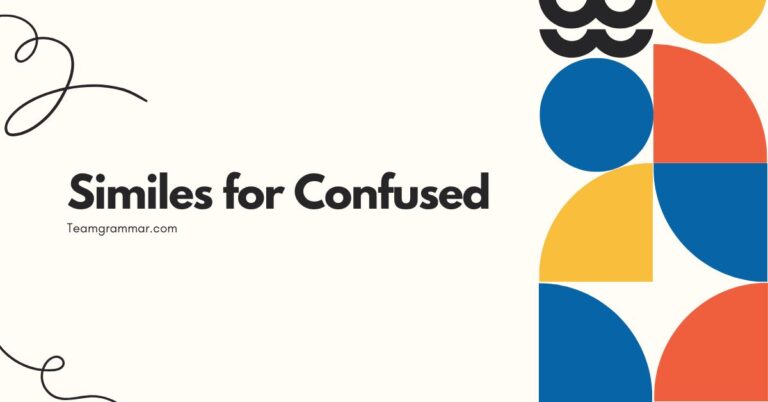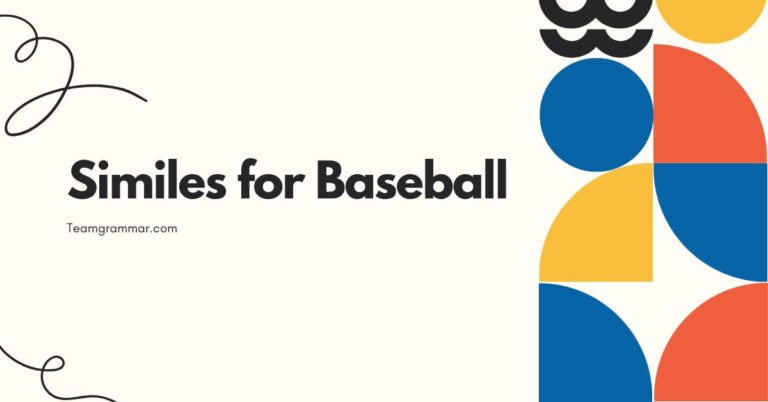33 Similes For Nice: A Comprehensive Guide to Descriptive Language
Similes are powerful tools in the English language that allow us to create vivid and engaging descriptions. When we want to express that something or someone is “nice,” we often resort to simple, straightforward language.
However, by using similes, we can elevate our writing and speech, making it more colorful and impactful. Understanding how to craft effective similes for “nice” not only enhances our descriptive abilities but also broadens our vocabulary and improves overall communication skills.
This guide is designed for English language learners, writers, and anyone looking to enrich their expressive capabilities, providing a detailed exploration of similes, their structure, and numerous examples to help you master this essential literary device.
Table of Contents
- Introduction
- Definition of a Simile
- Structural Breakdown of Similes
- Types of Similes
- Examples of Similes for “Nice”
- Usage Rules for Similes
- Common Mistakes When Using Similes
- Practice Exercises
- Advanced Topics in Simile Usage
- Frequently Asked Questions (FAQ)
- Conclusion
Introduction
The English language is rich with expressive tools, and similes are among the most versatile. They allow us to paint vivid pictures with words, making our communication more engaging and memorable.
When describing someone or something as “nice,” using similes can elevate our language from the mundane to the extraordinary. A simple adjective can be transformed into a powerful, evocative statement through the artful use of comparison.
This article will delve into the world of similes for “nice,” offering a comprehensive guide to understanding, crafting, and effectively using these figures of speech.
This guide is designed for a wide audience, including English language learners who want to expand their vocabulary and improve their descriptive writing, creative writers seeking to add depth and color to their prose, and anyone interested in mastering the nuances of the English language. By exploring the definition, structure, types, and usage rules of similes, you will gain the confidence and skills to use them effectively in your writing and speech.
Through numerous examples and practice exercises, this article will provide a practical and engaging learning experience, empowering you to express the concept of “nice” in a more creative and impactful way.
Definition of a Simile
Asimileis a figure of speech that compares two unlike things using the words “like” or “as.” It is a type of metaphor, but unlike a direct metaphor, it explicitly states the comparison. The primary function of a simile is to create a vivid image in the reader’s or listener’s mind by drawing a parallel between something familiar and something being described.
This comparison helps to highlight specific qualities or characteristics of the subject, making the description more impactful and memorable.
Similes are used extensively in literature, poetry, and everyday conversation to add color, depth, and clarity to language. They can be used to describe physical attributes, emotions, behaviors, and abstract concepts.
The effectiveness of a simile depends on the aptness of the comparison and the clarity with which it is presented. A well-crafted simile can transform a simple statement into a powerful and evocative image, enhancing the overall impact of the communication.
In the context of describing something as “nice,” similes can be particularly useful. The word “nice” itself is rather general and can encompass a wide range of positive qualities.
By using similes, we can specify exactly what aspect of “niceness” we are referring to, whether it is kindness, pleasantness, agreeableness, or some other related trait. This specificity adds depth and nuance to our descriptions, making them more meaningful and impactful.
Structural Breakdown of Similes
The structure of a simile is relatively simple, consisting of three main components: the subject being described, the comparison word (“like” or “as”), and the object to which the subject is being compared. Understanding this structure is crucial for creating effective and grammatically correct similes.
Let’s break down each component in more detail:
- Subject: This is the person, thing, or concept that is being described. It is the focus of the simile and the element whose qualities are being highlighted through the comparison.
- Comparison Word: The words “like” or “as” are used to explicitly state the comparison between the subject and the object. These words signal that a simile is being used, distinguishing it from a direct metaphor.
- Object: This is the person, thing, or concept to which the subject is being compared. It is chosen because it possesses a quality or characteristic that the speaker or writer wants to attribute to the subject. The object should be familiar and easily recognizable to the audience, so that the comparison is clear and impactful.
The basic formula for a simile can be represented as follows:
Subject + Comparison Word (“like” or “as”) + Object
For example:
She (Subject) is as (Comparison Word) sweet as honey (Object).
In this example, “she” is the subject, “as” is the comparison word, and “sweet as honey” is the object, conveying the idea that she possesses a high degree of sweetness similar to that of honey.
Another example:
His smile (Subject) was like (Comparison Word) sunshine on a cloudy day (Object).
Here, “his smile” is the subject, “like” is the comparison word, and “sunshine on a cloudy day” is the object, suggesting that his smile had a brightening and uplifting effect.
By understanding this structural breakdown, you can create your own similes by identifying the subject you want to describe, choosing an appropriate object for comparison, and connecting them with the word “like” or “as.” The key is to select an object that has a clear and relevant connection to the quality you want to emphasize in the subject.
Types of Similes
Similes can be categorized based on the type of comparison they make or the effect they create. While there isn’t a strict classification system, understanding different types can help you craft more effective and nuanced similes.
Here are a few common categories:
- Descriptive Similes: These similes focus on describing the physical attributes or qualities of the subject. They aim to create a vivid image in the reader’s mind by comparing the subject to something with similar characteristics.
- Emotional Similes: These similes are used to convey the emotions or feelings of the subject. They compare the subject’s emotional state to something that evokes a similar feeling, helping the reader to understand and empathize with the subject.
- Behavioral Similes: These similes describe the behavior or actions of the subject. They compare the subject’s actions to something that exhibits similar behavior, providing insight into their character or motivations.
- Abstract Similes: These similes compare abstract concepts or ideas to more concrete or tangible things. They help to make abstract ideas more understandable and relatable by grounding them in familiar experiences.
In the context of describing “nice,” similes can fall into several of these categories, depending on the specific aspect of niceness being emphasized. For example, a simile like “as kind as a saint” would be an emotional simile, highlighting the subject’s emotional quality of kindness.
A simile like “as pleasant as a summer breeze” would be a descriptive simile, focusing on the subject’s pleasantness and creating a sensory image.
By considering these different types of similes, you can choose the most appropriate type for your specific purpose and create similes that are both effective and impactful. The key is to think about the specific quality or characteristic you want to emphasize and then choose an object for comparison that clearly embodies that quality.
Examples of Similes for “Nice”
To illustrate the use of similes for “nice,” let’s explore various examples categorized by the specific aspect of niceness they convey. These examples will provide you with a range of options and inspire you to create your own unique similes.
General Niceness
These similes describe a general sense of niceness, without focusing on any specific aspect. They convey an overall positive impression of the subject.
The following table provides a comprehensive list of similes that describe general niceness. Each example offers a unique way to express the overall pleasant and agreeable nature of a person, thing, or situation.
| Simile | Explanation |
|---|---|
| As nice as pie | Indicates someone is very pleasant and agreeable. |
| As nice as can be | Emphasizes the subject is extremely pleasant in all aspects. |
| As nice as a summer day | Conveys a feeling of warmth, comfort, and pleasantness. |
| As nice as a dream | Suggests the subject is wonderful and delightful, like a pleasant dream. |
| As nice as a gentle breeze | Implies the subject is refreshing and calming. |
| As nice as a warm blanket | Evokes a sense of comfort and security. |
| As nice as a soft pillow | Suggests a feeling of relaxation and ease. |
| As nice as a purring kitten | Conveys a sense of contentment and affection. |
| As nice as a blooming flower | Implies beauty, freshness, and pleasantness. |
| As nice as a clear sky | Suggests clarity, peace, and optimism. |
| As nice as a sunny morning | Evokes a feeling of happiness and positivity. |
| As nice as a chocolate box | Implies sweetness and delight. |
| As nice as a holiday | Conveys a sense of relaxation and enjoyment. |
| As nice as a sweet melody | Suggests harmony and pleasantness. |
| As nice as a friendly face | Implies warmth and approachability. |
| As nice as a helping hand | Conveys kindness and support. |
| As nice as a kind word | Suggests thoughtfulness and care. |
| As nice as a thoughtful gift | Implies consideration and generosity. |
| As nice as a warm hug | Evokes a feeling of comfort and affection. |
| As nice as a peaceful moment | Conveys a sense of tranquility and calm. |
| As nice as a quiet evening | Suggests relaxation and serenity. |
| As nice as a good book | Implies enjoyment and enrichment. |
| As nice as a hot bath | Conveys a sense of relaxation and comfort. |
| As nice as a cup of tea | Suggests warmth and comfort. |
| As nice as a cozy fire | Implies warmth and security. |
Kindness-Related Similes
These similes highlight the kindness and compassion of the subject. They emphasize their caring and considerate nature.
The following table provides examples of similes that specifically relate to kindness. These comparisons emphasize the caring, compassionate, and considerate nature of a person or action.
| Simile | Explanation |
|---|---|
| As kind as a saint | Implies exceptional goodness and compassion. |
| As kind as a mother’s love | Conveys a deep and unconditional love. |
| As kind as a gentle nurse | Suggests caring and nurturing behavior. |
| As kind as a helpful neighbor | Implies willingness to assist others. |
| As kind as a generous friend | Conveys thoughtfulness and support. |
| As kind as a forgiving heart | Suggests compassion and understanding. |
| As kind as a warm smile | Implies friendliness and approachability. |
| As kind as a comforting word | Conveys empathy and support. |
| As kind as a helping hand | Suggests willingness to assist and support. |
| As kind as a gentle touch | Implies care and tenderness. |
| As kind as a soft whisper | Conveys gentleness and reassurance. |
| As kind as a loving gaze | Suggests affection and care. |
| As kind as a caring teacher | Implies patience and support. |
| As kind as a benevolent ruler | Conveys fairness and compassion. |
| As kind as a nurturing parent | Suggests care and support. |
| As kind as a charitable giver | Implies generosity and compassion. |
| As kind as a compassionate doctor | Conveys care and concern for others’ well-being. |
| As kind as a supportive sibling | Suggests loyalty and care. |
| As kind as a thoughtful gesture | Implies consideration and care. |
| As kind as a friendly gesture | Conveys warmth and approachability. |
| As kind as a comforting presence | Suggests reassurance and support. |
| As kind as a patient listener | Implies attentiveness and care. |
| As kind as a gentle soul | Conveys compassion and empathy. |
| As kind as a forgiving nature | Suggests understanding and compassion. |
| As kind as a merciful judge | Implies fairness and compassion. |
Pleasantness-Related Similes
These similes focus on the pleasant and enjoyable qualities of the subject. They emphasize their ability to bring joy and satisfaction.
The following table presents similes related to pleasantness, highlighting the enjoyable, delightful, and agreeable qualities of a person, thing, or situation.
| Simile | Explanation |
|---|---|
| As pleasant as a sunny day | Conveys warmth, happiness, and optimism. |
| As pleasant as a gentle rain | Suggests refreshment and tranquility. |
| As pleasant as a sweet song | Implies harmony and delight. |
| As pleasant as a cool breeze | Conveys refreshment and comfort. |
| As pleasant as a warm fire | Suggests comfort and security. |
| As pleasant as a blooming garden | Implies beauty and freshness. |
| As pleasant as a starlit night | Conveys wonder and tranquility. |
| As pleasant as a flowing river | Suggests peace and continuity. |
| As pleasant as a calm sea | Implies serenity and tranquility. |
| As pleasant as a gentle snowfall | Conveys peace and beauty. |
| As pleasant as a quiet forest | Suggests tranquility and peace. |
| As pleasant as a soft melody | Implies harmony and delight. |
| As pleasant as a good meal | Conveys satisfaction and enjoyment. |
| As pleasant as a sweet dessert | Suggests delight and indulgence. |
| As pleasant as a relaxing vacation | Implies enjoyment and freedom. |
| As pleasant as a funny joke | Conveys happiness and amusement. |
| As pleasant as a heartfelt compliment | Suggests appreciation and warmth. |
| As pleasant as a fond memory | Implies happiness and nostalgia. |
| As pleasant as a comfortable chair | Conveys relaxation and ease. |
| As pleasant as a good conversation | Suggests enjoyment and connection. |
| As pleasant as a shared laugh | Conveys happiness and connection. |
| As pleasant as a friendly chat | Suggests warmth and ease. |
| As pleasant as a casual stroll | Conveys relaxation and enjoyment. |
| As pleasant as a leisurely day | Suggests relaxation and freedom. |
| As pleasant as a well-deserved rest | Implies satisfaction and relaxation. |
Agreeableness-Related Similes
These similes highlight the subject’s agreeable and cooperative nature. They emphasize their willingness to get along with others and be accommodating.
The following table provides examples of similes that relate to agreeableness, emphasizing the cooperative, accommodating, and harmonious nature of a person or situation.
| Simile | Explanation |
|---|---|
| As agreeable as a consensus | Implies harmony and shared understanding. |
| As agreeable as a compromise | Suggests willingness to find common ground. |
| As agreeable as a friendly negotiation | Conveys cooperation and mutual respect. |
| As agreeable as a peaceful settlement | Implies resolution and harmony. |
| As agreeable as a cooperative partner | Suggests teamwork and collaboration. |
| As agreeable as a willing participant | Conveys enthusiasm and cooperation. |
| As agreeable as a compliant subject | Implies obedience and cooperation. |
| As agreeable as a harmonious relationship | Suggests balance and understanding. |
| As agreeable as a well-matched pair | Implies compatibility and harmony. |
| As agreeable as a unified team | Conveys collaboration and unity. |
| As agreeable as a diplomatic envoy | Suggests tact and understanding. |
| As agreeable as a conciliatory gesture | Implies willingness to reconcile. |
| As agreeable as a collaborative effort | Conveys teamwork and cooperation. |
| As agreeable as a sympathetic ear | Suggests understanding and support. |
| As agreeable as a receptive audience | Implies openness and acceptance. |
| As agreeable as a flexible schedule | Conveys adaptability and convenience. |
| As agreeable as a convenient arrangement | Suggests ease and suitability. |
| As agreeable as a suitable solution | Implies satisfaction and resolution. |
| As agreeable as a comfortable fit | Conveys ease and compatibility. |
| As agreeable as a balanced agreement | Suggests fairness and harmony. |
| As agreeable as a mutual understanding | Implies shared comprehension and harmony. |
| As agreeable as a shared vision | Conveys unity and purpose. |
| As agreeable as a united front | Suggests solidarity and cooperation. |
| As agreeable as a harmonious blend | Implies balance and compatibility. |
| As agreeable as a well-coordinated plan | Conveys efficiency and cooperation. |
Usage Rules for Similes
Using similes effectively requires adherence to certain rules to ensure clarity, impact, and grammatical correctness. Here are some key rules to keep in mind:
- Clarity of Comparison: The comparison should be clear and easily understood by the audience. The object of comparison should have a readily apparent connection to the quality being emphasized in the subject. If the connection is too obscure or requires specialized knowledge, the simile will lose its effectiveness.
- Relevance of Comparison: The object of comparison should be relevant to the context and the overall message being conveyed. An irrelevant or nonsensical comparison can be confusing and distracting.
- Grammatical Correctness: The simile should be grammatically correct. The subject and object of comparison should be properly connected with the words “like” or “as,” and the sentence structure should be clear and logical.
- Originality and Freshness: While common similes can be effective, using original and fresh similes can make your writing more engaging and memorable. Avoid clichés and strive to create unique comparisons that capture the reader’s attention.
- Appropriateness of Tone: The tone of the simile should be appropriate for the context and the overall tone of the writing. A simile that is too informal or humorous may be inappropriate for a serious or formal context.
Exceptions and Special Cases:
- Implied Similes: In some cases, the comparison word (“like” or “as”) may be omitted, creating an implied simile. However, this should be done carefully to ensure that the comparison is still clear and easily understood.
- Extended Similes: An extended simile is a simile that is developed over several sentences or paragraphs. This allows for a more detailed and nuanced comparison, but it should be used judiciously to avoid overwhelming the reader.
By following these usage rules, you can create similes that are both effective and impactful, enhancing the clarity and expressiveness of your writing.
Common Mistakes When Using Similes
Even experienced writers can make mistakes when using similes. Being aware of these common errors can help you avoid them and improve the quality of your writing.
Here are some frequent mistakes to watch out for:
- Using Clichés: Clichés are overused similes that have lost their impact and originality. Examples include “as blind as a bat” or “as strong as an ox.” While clichés can be convenient, they often make your writing sound uninspired and predictable. Instead, strive to create fresh and original comparisons.
- Creating Unclear Comparisons: The comparison in a simile should be clear and easily understood. Avoid using obscure or ambiguous objects of comparison that may confuse the reader. The connection between the subject and the object should be readily apparent.
- Using Illogical Comparisons: The comparison should be logical and make sense within the context of the writing. Avoid comparing things that have no real connection or that create a nonsensical image.
- Overusing Similes: While similes can be effective, using too many of them can make your writing sound forced and artificial. Use similes sparingly and only when they add value to the writing.
- Misusing “Like” and “As”: Remember that “like” is used to compare nouns or pronouns, while “as” is used to compare clauses or phrases. Using these words incorrectly can create grammatical errors and confuse the reader.
Correct vs. Incorrect Examples:
| Incorrect | Correct | Explanation |
|---|---|---|
| She was as busy as a bee. | She was as busy as a one-armed paper hanger. | The original simile is a cliché. The revised simile provides a more fresh and vivid comparison. |
| He was as tall as a building. | He was as tall as a skyscraper. | The revised simile is more specific and creates a clearer image. |
| The idea was like a fish. | The idea was like a slippery fish, hard to catch and hold onto. | The revised simile adds more detail and clarifies the comparison. |
By being mindful of these common mistakes, you can avoid them and create similes that are clear, effective, and impactful.
Practice Exercises
To solidify your understanding of similes for “nice,” complete the following practice exercises. These exercises will help you identify, create, and use similes effectively in your writing.
Exercise 1: Identifying Similes
Identify the similes in the following sentences:
| # | Sentence | Answer |
|---|---|---|
| 1 | Her smile was as warm as the sun. | As warm as the sun |
| 2 | He is kind like his father. | Like his father |
| 3 | The day was as pleasant as a dream. | As pleasant as a dream |
| 4 | She is as agreeable as a consensus. | As agreeable as a consensus |
| 5 | His words were like a gentle breeze. | Like a gentle breeze |
| 6 | The music was as sweet as honey. | As sweet as honey |
| 7 | He is as nice as can be. | As nice as can be |
| 8 | The atmosphere was like a warm hug. | Like a warm hug |
| 9 | She is as patient as a saint. | As patient as a saint |
| 10 | His heart is like a golden treasure. | Like a golden treasure |
Exercise 2: Completing Similes
Complete the following similes by filling in the blank:
| # | Sentence | Answer |
|---|---|---|
| 1 | She is as nice as _____. | pie |
| 2 | He is as kind as _____. | a saint |
| 3 | The day was as pleasant as _____. | a dream |
| 4 | She is as agreeable as _____. | a compromise |
| 5 | His words were like _____. | a gentle breeze |
| 6 | The music was as sweet as _____. | honey |
| 7 | He is as nice as _____. | can be |
| 8 | The atmosphere was like _____. | a warm hug |
| 9 | She is as patient as _____. | a saint |
| 10 | His heart is like _____. | a golden treasure |
Exercise 3: Creating Similes
Create your own similes to describe the following:
| # | Topic | Answer |
|---|---|---|
| 1 | A nice person | As nice as a warm summer day. |
| 2 | A kind gesture | As kind as a helping hand in need. |
| 3 | A pleasant surprise | As pleasant as finding a hidden treasure. |
| 4 | An agreeable situation | As agreeable as a peaceful resolution. |
| 5 | A nice compliment | Like a ray of sunshine on a cloudy day. |
| 6 | A kind heart | As kind as a mother’s love. |
| 7 | A pleasant voice | As pleasant as a gentle melody. |
| 8 | An agreeable partner | As agreeable as a perfectly matched piece. |
| 9 | A nice smile | Like sunshine breaking through the clouds. |
| 10 | A kind soul | As kind as an angel’s whisper. |
Advanced Topics in Simile Usage
For advanced learners, there are several more complex aspects of simile usage to explore. These topics delve into the nuances of simile construction and application, allowing you to refine your skills and create even more impactful and sophisticated comparisons.
- Subverting Expectations: Experiment with creating similes that challenge or subvert the reader’s expectations. This can be achieved by comparing seemingly unrelated things or by using unexpected or ironic language. The key is to create a comparison that is both surprising and meaningful.
- Using Similes to Create Tone and Mood: Similes can be used to create a specific tone or mood in your writing. By carefully selecting the object of comparison and the language used to describe it, you can evoke a range of emotions and create a desired atmosphere.
- Combining Similes with Other Figures of Speech: Similes can be combined with other figures of speech, such as metaphors, personification, and hyperbole, to create even more complex and layered effects. This requires a deep understanding of each figure of speech and how they can be used together effectively.
- Using Similes in Different Genres: The use of similes can vary depending on the genre of writing. For example, similes may be used more frequently and creatively in poetry and fiction than in academic or technical writing. Understanding the conventions of different genres can help you use similes appropriately and effectively.
By exploring these advanced topics, you can take your simile skills to the next level and create writing that is both creative and impactful.
Frequently Asked Questions (FAQ)
Here are some frequently asked questions about similes, along with detailed answers to help you further understand this important figure of speech:
- What is the difference between a simile and a metaphor?
A simile is a comparison between two unlike things using “like” or “as,” while a metaphor is a direct comparison that states one thing *is* another. Similes are explicit; metaphors are implicit.
- Can a simile be a cliché?
Yes, if a simile is overused and has lost its originality, it becomes a cliché. It’s best to avoid clichés and create fresh, original comparisons.
- How can I create more original similes?
To create original similes, think beyond the obvious. Consider unusual comparisons, focus on specific details, and use vivid language to bring your similes to life. Brainstorming and experimenting with different ideas can help.
- Is it okay to use similes frequently in my writing?
While similes can enhance your writing, overuse can make it feel forced. Use them judiciously, only when they add value and clarity to your descriptions.
- What if my simile is not immediately understood by the reader?
If a simile is not immediately clear, it may be too obscure. Revise it to use a more familiar object of comparison or add more context to clarify the connection between the subject and the object.
- Can similes be used in formal writing?
Yes, similes can be used in formal writing, but they should be used sparingly and with careful consideration of the tone and context. Avoid overly informal or humorous similes in formal settings.
- How do I choose the right object for my simile?
Choose an object that has a clear and relevant connection to the quality
to emphasize in the subject. The object should be familiar and easily recognizable to your audience.
Conclusion
Similes are a valuable tool for enhancing descriptive writing and making language more engaging and impactful. By understanding the structure, types, and usage rules of similes, you can effectively use them to describe various aspects of “nice,” such as general niceness, kindness, pleasantness, and agreeableness.
Avoiding common mistakes and practicing regularly will further refine your skills and allow you to create original and compelling comparisons.
This comprehensive guide has provided you with the knowledge and resources to master the art of using similes for “nice.” Whether you are an English language learner, a creative writer, or simply someone looking to improve your communication skills, the techniques and examples presented here will empower you to express yourself more effectively and creatively. Embrace the power of similes and elevate your writing to new heights.







